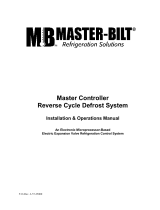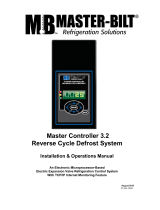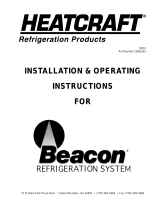Page is loading ...

5/16 Rev. B 57-02491 1
Master Controller Setting Quick Reference Guide
(MB P/N: 19-4153 with Pressure Transducer)
NOTE: If you are replacing a Master Controller control board in a walk-in cooler or freezer with either
electric or reverse cycle defrost, please see the list of typical set points on page 4. The chart shows the
correct settings to follow for each defrost type.
Setting the Master Controller by Two On-Board Pushbuttons: SW1 & SW2
CHANGING THE ROOM TEMPERATURE SET POINT
Press and hold ‘SW2’ until the green LED starts blinking. The display will toggle between ‘rS’ and the room temperature set
point. The red LED will be on if the set point is negative. Press ‘SW1’ to increase ‘rS’ by 1
o
F. Press ‘SW2’ to decrease ‘rS’
by 1
o
F. If no button is pushed for 20 seconds, the controller will take the new set point.
CHANGING ALL SET POINTS
Press and hold ‘SW1’ and ‘SW2’ simultaneously until the green LED starts blinking. The display will toggle between ‘ro’
and the actual room temperature. To scroll down, press ‘SW2’. Pressing ‘SW1’ will increase the set point by one increment.
When the set point gets to its maximum value, pressing ‘SW1’ will rotate it to its minimum value.
CLEARING AN ALARM
Press ‘SW1’ three times within five seconds to clear all alarms and restart timer.
MANUAL DEFROST
Pressing and holding pushbutton SW1 for 7 seconds will cause the controller to go into defrost cycle.
STATUS, DEFAULT AND READING DISPLAY
The status and the digital data can be displayed on both the onboard two-digit display and the remote panel display. Below is
a list of the parameters of the operational status.
Onboard Optional
Two-Digit Panel
Display Display Description
SU STUP Indicates the status of Start Up Mode
CF CKFN Check fan working status. The fans run than stop during start-up mode
CP CKP1 Check pressure transducer
oP OKP1 Indicates the pressure transducer is working as it should
C1 CKT1 Check sensor TS1, the evaporator inlet/defrost termination temperature sensor
o1 OKT1 Indicates the TS1 is working as it should
C2 CKT2 Check sensor TS2, the evaporator suction outlet/fan cut-in temperature sensor
o2 OKT2 Indicates the TS2 is working
C3 CKT3 Check sensor TS3, the refrigerated room temperature sensor
o3 OKT3 Indicates the TS3 is working
FH CKFH Indicates all sensors are OK
Fd FNDL Indicates FAN DELAY MODE
FP FDTP Actual TS2 value in FAN DELAY
CL COOL Indicates COOL MODE
oF OFF Indicates OFF MODE
Pd PMDN Indicates PUMPDOWN MODE before an electric defrost
dF DEFR Indicates DEFROST MODE
Cd DRIP Indicates COIL DRAIN MODE
dn DFTP Inlet sensor TS1 value in DEFROST MODE

5/16 Rev. B 57-02491 2
CHANGING PARAMETERS
A list of the parameters that can be displayed and/or changed is shown below when access to the default settings is needed.
This access is usually done by a trained technician.
Onboard Optional
Two-Digit Remote Panel
Display Display Description
ro RMTP Refrigerated room temperature from TS3 (-40
o
F to +99
o
F), displayed value
Eo POSN Percentage the valve is open (0 to 99%)
SH SUPH Actual superheat in COOL MODE (TOUT-TSAT)
in TSAT Saturated suction temperature calculated from suction pressure Pr
oU TOUT Evaporator suction outlet temperature from TS2
dE DFTP Temperature read from the evaporator defrost termination sensor TS1
Pr PRES Suction pressure read from the pressure transducer (-14.6 to 99.0PSIG)
Note: the above parameters are status variables that allow you to check the system operations;
the below parameters are set points that can be changed to fit the applications
Cn CMMD The address to show if the evaporator operates as master/slave, standalone,
or alternating mode
Ao ALON Indicates a standalone system (One condensing unit + one evaporator)
n1-5 MSS1-5 Indicates if the controller is a master. The “1-5” shows the number of slaves that are
supposed to be connected to this master.
S1-5 SLV1-5 Indicates if the controller is a slave. The “1-5” shows the address of this slave.
nL MSAL Primary evaporator of the two alternating controllers
SL SLAL Secondary evaproator of the two alternating controllers
nS MSGP The address group for a master/slave group or alternating duo ( nS=0 ), not used
SS SHSP Superheat set point (5 to 20
o
F).
rS RMSP Room temperature set point or cut-out (-40 to
+75
o
F, set point range)
dU DFTM Maximum defrost duration (10 to 99 minutes, five minute increment)
dS DFSP Defrost termination temperature (40 to 90
o
F, 5
o
F degree increment)
PU PDTM Pump down timeout duration (0 to 5 minutes)
dr DRTM Drip time duration (0 to 10 minutes)
nd NMDF Number of defrosts per day (0 to 12). When nd = 0, demand defrost, when nd = 1 to 12,
the controller uses scheduled defrost
HA HIAL High temperature alarm set point (-35 to +60
o
F, 5
o
F degree increment)
Ad ALDL Temperature alarm delay (10 to 59 minutes, 5 minute increment)
LA LOAL Low temperature alarm set point (-40 to +55
o
F, 5
o
F degree increment)
oC OFTM Minimum time the valve is close (0 to 15 minutes)
rn RNTM Minimum time the valve is open (0 to 15 minutes)
rP RNTP Cut-in temperature differential (0 to +25
o
F)
PS MPSP Maximum suction pressure set point (-4.6 to 99.0 PSIG)
Pn NPSP Minimum pressure set point (-14.6 to 3 PSIG)
Hb 8HR, 12HR, When in demand defrost and temperature set point is below 35°F, if ‘8HR’,
24HR, 48HR, 72HR then a defrost will occur at least once every 8 hours. If ‘12HR’, then a defrost
will occur at least once every 12 hours. If ‘24HR’, then a defrost will occur at least
once every 24 hours. If ‘48HR’, then a defrost will occur at least once every 48 hours. If
‘72HR’, then a defrost will occur at least once every 72 hours
Ar LGAD Address of controller for remote data logging (Ar = 0), not used
Er DFMD Defrost type (electric or reverse cycle, EL, r1 and r2)
rr REFR Refrigerant type, R404 (4A) or R22 (22)
AL DIF2 If in alternating mode, number of degrees above cut-in (cut-out + rP) set point to
override and both controllers to go into cool mode (3-10
o
F)

5/16 Rev. B 57-02491 3
ALARM DISPLAY
Any alarm will cause relay #3 to switch. All alarms have a distinct display on the controller. The green LED will be on and
the red LED will blink. Multiple alarms can exist. There is a priority as to which alarm will be displayed before another.
Onboard Optional
2 Digit Remote Panel
Display Display Description PRIORITY
NOAL Displays when there are no alarms. The onboard 2 digit display
will display status and temperature readings
SP PRSR Pressure transducer 1
So SCSR Evaporator outlet temperature sensor TS2 alarm 2
SA RMSR Room temperature sensor TS3 alarm 3
LS LOSH Low superheat alarm 4
rH HIRM High room temperature alarm 5
rL LORM Low room temperature alarm 6
Sd INSR Defrost termination sensor TS1 alarm 7
LP LPAL Low pressure alarm 8
CA CMAL Communication alarm 9
TROUBLESHOOTING GUIDE
Trouble, Alarm Codes Causes Corrective Actions
Pressure transducer alarm
SP, PRSR
•
Bad transducer
• Out of range
• Loose wire
• Wrong hook-up
•
Replace the pressure transducer
• Turn off power for a few seconds, turn back on
•
Wire correctly
Outlet sensor TS2 fails
So
SCSR
•
Mechanical damage
• Connection wire loose
• Overheated
• Out of range
•
Tighten the connection wires on the controller
terminal
• When brazing suction line, take out the sensor
• Install the sensor after brazing
Room sensor TS3 fails
SA
RMSR
•
Mechanical damage
• Connection wire loose
• Overheated
• Out of range
•
Tighten the connection wires on the controller
terminal
• The room sensor can be replaced by surface sensor
Low superheat
LS
LOSH
•
Superheat setting too low
• Wrong locations of TS2
• Sensors may be loose
• Uneven feeding of coil circuits
• Overcharge of refrigerant
Defective electric expansion valve (EEV)
• Compressor stops
•
Change to correct set point
• Make sure the distributor is feeding each circuit
evenly
• Insulate the sensors with foam tape
• Use correct refrigerant charge
• Check EEV wiring
• Replace defective EEV
• Check compressor
High room temperature
rH
HIRM
•
Insufficient refrigeration
• Heat load too large
• Compressor fails or high pressure cuts out
• Evaporator fans may not run
• Door open for too long
• Coil iced-up
•
Check system design to select a sufficient system
• Replace failed compressor
• Fix the evaporator fans
• Keep the cold room door closed during refrigeration
• Check possible air leak through the walls of cold
room
Low room temperature
rL, LORM
•
Inproper low temp setpoint
• Over designed system
•
Change low temp set point
• Re-select the system
Defrost termination sensor TS1 fails
Sd, INSR
•
Mechanical damage
• Loose connection wire
• Overheated
• Out of range
•
Tighten the connection wires on the controller
terminal
• Let the sensor cool down to application temperature
range: –50
o
F to +103
o
F
• Replace failed sensor
Low pressure alarm
LP, PAL
•
Refrigerant leak
• Bad transducer
•
Fix leak
• Replace pressure transducer
Communication
CA, CMAL
•
Loose RS-485 coonection
• Failed communication port
•
Tighten the terminals
• Change a new controller board

5/16 Rev. B 57-02491 4
Temperature Sensor The resistance of the temperature sensor at 32
o
F ice water is 5,122 ohms.
Pressure Transducer RED --- +5VC, Green --- Signal Voltage, Black --- Ground; Compare gauge pressure and the “Pr”
suction pressure on-board reading to make sure they both read the same (PSIG)
Electric Expansion Valve
1) The resistance between the black and white leads should be around 90 ohms. The resistance between
the black and red leads should be an open.
2) The resistance between the red and green leads should be around 90 ohms. The resistance
between the white and green leads should be an open.
3) The resistance between each lead and the brass housing of the valve should be an open
4) Read the AC, not DC, voltage across the black and white leads while the valve is
moving. The AC voltage should be 11 to 13 VAC. The voltage will be close to 0 VAC when the valve
is not moving.
5) Repeat step 4 across the red and green leads
External Relay The DC voltage between terminal ‘B’ and ‘W’ on board is 12VDC in Cool Mode
TYPICAL SET POINTS FOR CONTROLLER
Electric Defrost Reversing Cycle Defrost
Low Temp High Temp Low Temp High Temp
MCD
WG
Cn CMMD Ao Ao Ao Ao
Ao
Ao
nS MSGP 0 0 0 0 0 0
SS SHSP 10 10 10 10
10
10
rS RMSP -10 35 35 -10 -10 35
dU DFTM 35 35 35 20 20 20
dS DFSP 75 45 45 60 60 60
PU PDTM 3 3 3 3 3 3
dr DRTM 2 2 2 5 5 2
nd NMDF 0 0 0 0 0 0
HA HIAL 25 50 50 25
5
50
Ad ALDL 59 59 59 59 59 59
LA LOAL -20 20 20 -20 -20 20
oC OFTM 2 2 2 2 2 2
rn RNTM 2 2 2 2 2 2
rP RNTP 5 3 3 5 5 3
PS MPSP 55 80 80 55 55 80
Pn NPSP 0 0 0 0 0 0
Hb 8, 12 24,
48, 72
12 24 24 12 12 24
Ar LGAD 00 00 00 00 00 00
Er DFMD EL EL EL r1
r2
r1
rr REFR 4A 22
4A
4A 4A 22
AL DIF2 5 5 5 5 5 5
Please check with factory for actual set points on individual controllers.
For complete information, please refer to the Master Controller Installation & Operations Manual or contact:
Master-Bilt Products
Technical Service Department
Highway 15 North
New Albany, MS 38652
Phone: 800-684-8988
Fax: 800-684-8988
Email: service@master-bilt.com
/











